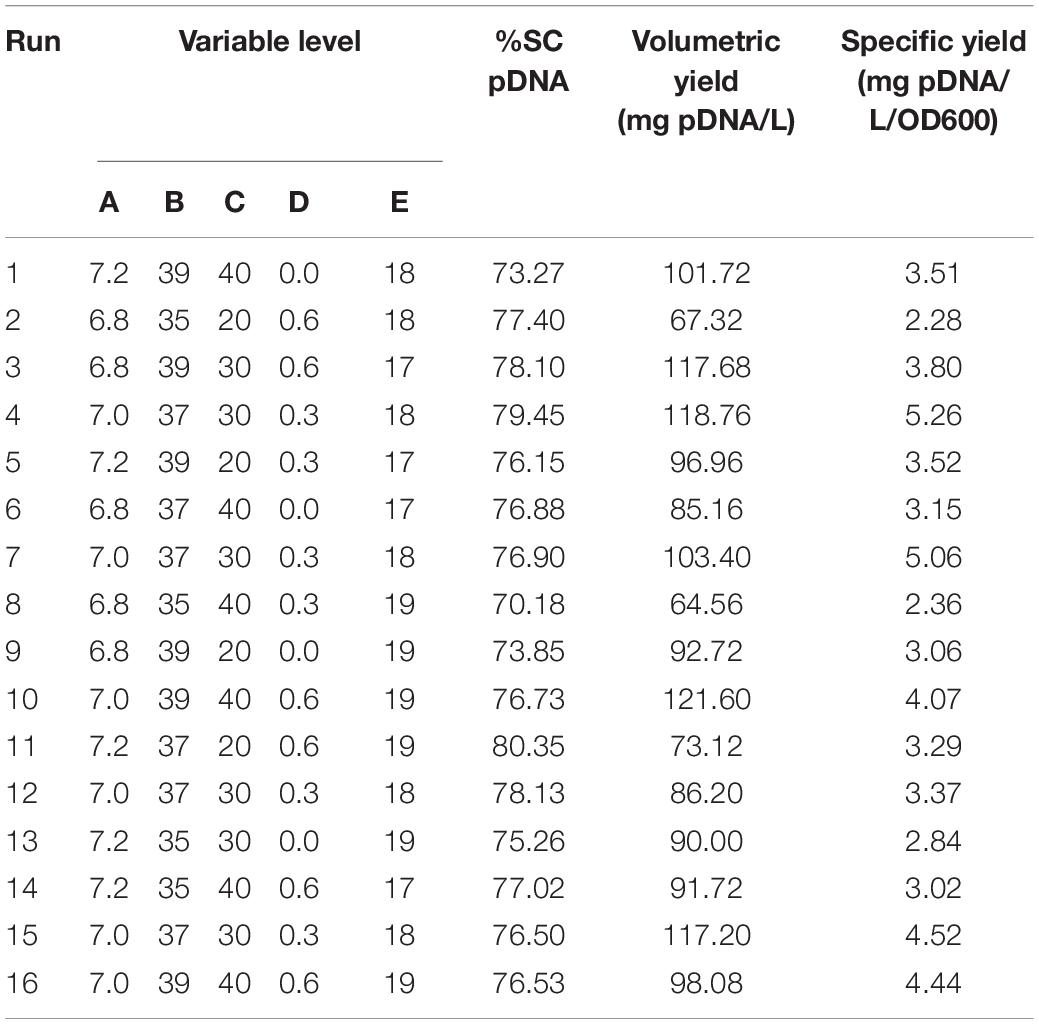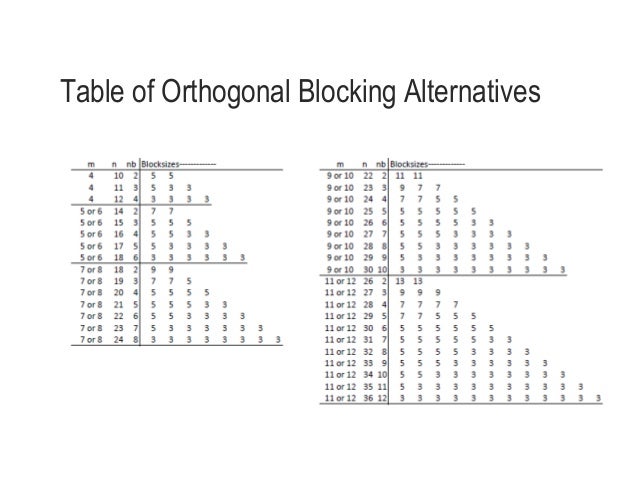Table Of Content

Likewise, all rows within this DSD array (except for the center points) are a pairwise mirror image of another row. The list ranges from a full 2-level factorial design consisting of all 32 combinations of the low and high levels of the 5 factors to a quarter fraction in 8 runs. As noted earlier, the 25-1 half fraction is very popular since it is resolution V and therefore does not confound any of the main effects or 2-factor interactions.
Statgraphics
Of course, compared to dedicated response surface designs, the power level to detect quadratic effect is certainly much lower. In that respect, DSDs might appear to be a less expensive alternative to Central Composite or Box-Behnken designs, with a much smaller amount of runs, only one center point and obviously much less power. Notice that each factor is run 5 times at its low level, 5 times at its high level, and 3 times at a value halfway between the low and the high. Note also that the 3 central values for each factor are run once at the low level of every other factor, once at the high level of every other factor, and once at the central level of each factor.
Screening Designs
Efficient optimization approaches for microwave assisted extraction of high-quality antioxidant compounds from Salvia ... - ScienceDirect.com
Efficient optimization approaches for microwave assisted extraction of high-quality antioxidant compounds from Salvia ....
Posted: Tue, 25 Jul 2023 20:23:53 GMT [source]
In order to maintain the visual interest of a neighborhood, it is important that the design of new buildings and renovations to existing buildings be compatible with nearby buildings. A single building out of context with its surroundings can be disruptive to the neighborhood character and, if repeated often enough, to the image of the City as a whole. With a single center point, only quadratic effects that are strong enough will become noticeable. Anyway, if the objective is to identify the optimum, the experimenter is likely to be interested only in large curvatures that markedly differ from a simple linear model. In San Francisco, the Fire Department is responsible for R-2 buildings.
Example of Create Definitive
This might lead an investigator, using a classical 2-level screening or fractional factorial design, to falsely screen out a factor as having no (linear) effect when in fact it is important to the process. The ability to estimate quadratic terms for and attribute curved as well as linear behaviour to the factors under study. Besides definitive screening designs, 2 common types of screening designs are Plackett-Burman designs and resolution III fractional factorial designs. Both Plackett-Burman designs and resolution III fractional factorial designs are 2-level designs. The most notable way that definitive screening designs differ from standard designs is that all the factors are numeric and tested at three levels. A second distinctive feature of a definitive screening design is that it is a self-foldover.
Adding a new building to my lot
Notice that it has one more than twice as many runs as there are factors, that is, 17 runs. In a resolution IV design, terms for main effects are not aliased with 2-way interactions. In definitive screening designs, 2-way interactions are usually partly confounded with each other and square terms, but you can still estimate some 2-way interactions. Square terms are not aliased with terms for main effects, so you can estimate some square terms. In many cases, you can estimate all 2-way interactions and square terms that involve any 3 factors in the experiment. For more information on aliasing, go to What are confounding and alias structure?.
In recent years, a class of experimental designs called "Definitive Screening Designs" have been developed that enable experimenters to fit a response surface model without doing additional runs. The initial set of runs has enough levels of each factor so that once insignificant factors have been eliminated, a second-order model with quadratic effects can be estimated in the remaining factors. Comparable in size to factorial experiments, they are a good alternative when curvature in the response variable is expected and the experimenter wants to avoid doing a second set of experimental runs. Statgraphics 18 includes definitive screening designs in its design catalog.
As we shall see, a definitive screening design exists in 13 runs that provides an alternative to the fractional factorial design. We'll also discuss the strengths and weaknesses of the 2 design choices. Wow, DSDs, with their desirable combinatorial structure, look extremely useful and resource efficient alternative designs to the classical 2-level screening designs we described above. Since both authors of DSDs are leading practitioners and proponents in the optimal design of experiments, it might not come as any surprise to learn that DSDs in fact started life as alias-optimal[2] designs. Perhaps at first it would therefore appear fascinating that DSDs have such a balanced, practical and appealing combinatorial structure. I use the correlation cell plot here to show why definitive screening designs are definitive.

Definitive screening designs
Optimization of membrane dispersion ethanol precipitation process with a set of temperature control improved ... - Nature.com
Optimization of membrane dispersion ethanol precipitation process with a set of temperature control improved ....
Posted: Wed, 04 Nov 2020 08:00:00 GMT [source]
By contrast, the definitive screening design can separately estimate the nonlinear effect of each factor. DSDs can also be considered as screening designs, since the number of terms to estimate in a full quadratic model, for example, is usually much larger than the number of tests. Traditional, Plackett Burman screening designs enable one to study main effects only, whereas Definitive Screening Designs can be used to study the effects of main effects as well as two factor interactions and quadratic effects. The purpose of screening is to separate the vital few factors that have a substantial effect on the response from the trivial many that have negligible effects. If a factor’s effect is strongly curved, a traditional screening design may miss this effect and screen out that factor. If there is a two-factor interaction, standard screening designs having a similar number of runs to the definitive screening design with the same number of factors will require follow-up experimentation to resolve the ambiguity.
Due to their special structure however, DSDs can project to highly efficient response surface designs in the presence of sparsity in the number of active factors. Let us compare this design and plot to the standard screening design for eight factors. That design is the minimum aberration fractional factorial design. This design is in Table 2, which has one added center run to make both designs have 17 runs, including one center run.
At this point, we would have correctly identified the 3 active factors, although we haven't yet detected the interaction between temperature and catalyst. The use of experimental design for process optimization is a well-established technique that encourages efficient use of experimental resources. It's one of those areas of statistical analysis where the ROI is relatively easy to quantify and can be extremely high.
The fold-over structure of DSDs results in orthogonal main effects, and main effects are also orthogonal to all second-order effects. The colourful correlation cell matrix below emphasises these particularly desirable properties. Desirable, because screening designs are primarily intended to support first order models, but there is often concern that responses might exhibit strongly curved behaviour over the factor ranges.
If that’s not possible, you must provide a mechanical ventilation system. All living spaces in the City must have natural light, also called exposure. The City uses the term glazing to refer to glass in windows, doors, or other fixed openings that let natural light into a building. An unlicensed person cannot design multiple clusters of up to 4 dwelling units. Multiple-unit dwellings containing less than 5 dwelling units of wood construction that are less than 2 stories and basement in height.
The engineers decide to use a definitive screening design that can estimate the square terms with 17 runs. Definitive screening designs include runs that are not in 2-level designs so that you can use definitive screening designs to estimate square terms. An example of a curved relationship is the amount of nitrogen in soil and the amount of fruit a plant produces. The addition of the right amount of nitrogen increases fruit production, but the addition of too much nitrogen decreases fruit production.
Definitive Screening Designs are three level designs that enable one to study second order, quadratic effects. However, with only one center point and a number of runs that is much smaller than in a standard response surface design, the probability to detect significant quadratic terms (the power level) is certainly not as high. The engineer refines the model further and finds that the CE interaction and the GG square term remain statistically significant when the model includes those terms. The engineer decides that factors B and F do not have large main effects and are not likely to be in any large 2-way interactions. The engineer decides that the result of the screening experiment is that the engineer can exclude factors B and F in further experiments to understand the process better.
No comments:
Post a Comment